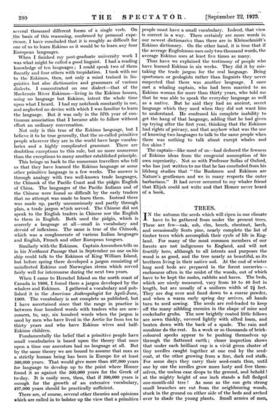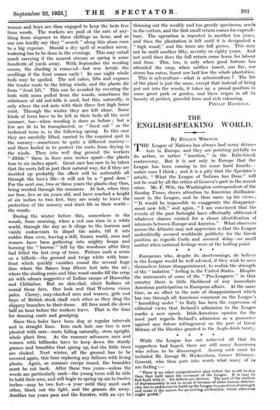TREES.
IN the autumn the seeds which will ripen in our climate have to be gathered from under the present trees. These are few—oak, ash, elm, beech, chestnut, larch, and occasionally Scots pine, nearly complete the list of timber trees which accomplish their cycle of life in Eng- land. For many of the most common members of our forests are not indigenous to England, and will not fructify here, although to all intents and purposes the wood is as good, and the tree nearly as beautiful, as its brethren living in their native soil. At the end of winter long seed beds are prepared in the forest nurseries—. enclosures often in the midst of the woods, out of which have to be kept the moles, rabbits and hares. The beds, which are nicely measured, vary from 10 to 40 feet in length, but are usually of a uniform width of 2i feet. They are dug over and fined down to a coarse powder, and when a warm early spring day arrives, all hands turn to seed sowing. The seeds are red-leaded to keep off the many nibbling enemies in the shape of mice and cockchafer grubs. The now brightly coated little fellows are sown thickly, covered lightly with sifted loam, and beaten down with the back of a spade. The rain and sunshine do the rest. In a week or so thousands of brick- coloured specks appear to be pushing themselves up through the flattened earth ; closer inspection shows that under each brilliant cap is a vivid green cluster of tiny needles caught together at one end by the seed- coat, at the other growing from a fine, dark red stalk. For some days they carry their seed-coats thus, until one by one the needles grow more lusty and free them- selves, the useless case drops to the ground, and behold at the mighty height of one inch stands a full fledged one-month-old tree ! As soon as the sun gets strong small branches are cut from the neighbouring woods, stuck in the ground on either side of the beds and arched over to shade the young plants. Small armies of men, women and boys are then engaged to keep the beds free fiom weeds. The workers are' paid at the rate of any- thing from sixpence to three shillings an hour, and as one can hardly say they " scorch " along this alone runs to a big expense. Should a dry spell of weather occur, watering has to be done in the evenings. This may entail much carrying if the nearest stream or spring is some hundreds of yards away. With September the weeding ceases, the shading is removed—but woe betide the seedlings if the frost comes early ! In one night whole beds may be spoiled. The soil cakes, lifts and exposes the tender roots to the biting winds, and the plants die from " frost lift." This can be avoided by covering the beds with moss pulled from the woods, sometimes the substance of old ant-hills is used, but this, naturally, is only where the red ants with their three feet high home exist. Through the winter they arc left alone. Some kinds of trees have to be left in their beds all the next summer, too—when weeding is done as before ; but a few are fit to be transplanted, or " lined out " as the technical term is, in the following spring. In this case they are carefully lifted, carried to the required spot in the nursery—sometimes to quite a different nursery— and there heeled in to protect the roots from drying in the winds. Then into well dug ground the workers " dibble " them in lines nine inches apart—the plants four to six inches apart. Great care has now to be taken that the roots fall in just their natural way, for if they are doubled up probably the effect will be noticeable all through the tree's life—it will not be a " good doer." For the next one, two or three years the plants stay thus, being weeded through the summers. At last, when they are four, five or six years old, and have reached a height of six inches to two feet, they are ready to leave the protection of the nursery and start life in their world— the woods.
During the winter before this, somewhere in the woods, from morning, when a red sun rises in a white world, through the day as it clings to the horizon and vainly endeavours to dispel the mists, till it sets redder than ever, leaving a still, frozen world, men and women have been gathering into mighty heaps and burning the " browse " left by the woodmen after they had felled the last crop of trees. Picture such a scene on a hillside—the ground and twigs white with hoar- frost which quickly vanishes round the several huge fires where the flames leap fifteen feet into the air ; where the sizzling resin and blue wood smoke fill the crisp air with odours suggestive of Indian camps of Hiawatha and Chibiabus. But no skin-clad, silent Indians sit round those fires. One look and that Western vision pales. Cheery, rosy-cheeked men and women, girls and boys of British stock chaff each other as they drag the slippery branches to their doom. All fires must die down half an hour before the workers leave. That is the time for donning coats and gossiping.
Since then holes have been dug at regular intervals and in straight lines. Into each hole one tree is now planted with care—roots falling naturally, stem upright, whole plant firm. As the summer advances men and women with billhooks have to keep down the sturdy grasses and brambles that spring up, lest the little trees are choked. Next winter, all the ground has to be covered again, this time replacing any failures with living plants. Again, as summer creeps round, the brambles must be cut back. After these two years—unless the weeds are particularly rank—the young trees will be able to hold their own, and will begin to spring up six to twelve inches—may be two feet—a year until they meet each other, block out the light, and the grasses die away. :Another ten years pass and the forester, with an eye to thinning out the weakly and too greedy specimens, sends in the cutters, and the first small return comes for expendi- ture. The operation is repeated in another ten years, and then the plantation is left until it is designated a " high wood," and the trees are full grown. This may not be until another fifty, seventy or eighty years. And not until then does the full return come home for labour and time. This, too, is only when good fortune has attended the crop, when neither insect, nor fire, nor storm has eaten, burnt nor laid low the whole plantation.
This is sylviculture—what is arboriculture ? The life of the plant is just the same, except that instead of being put out into the woods, it takes up a proud position in some great park or garden, and there reigns in all its beauty of perfect, graceful form and rich colouring.
PHILLIP HASTINGS.







































 Previous page
Previous page